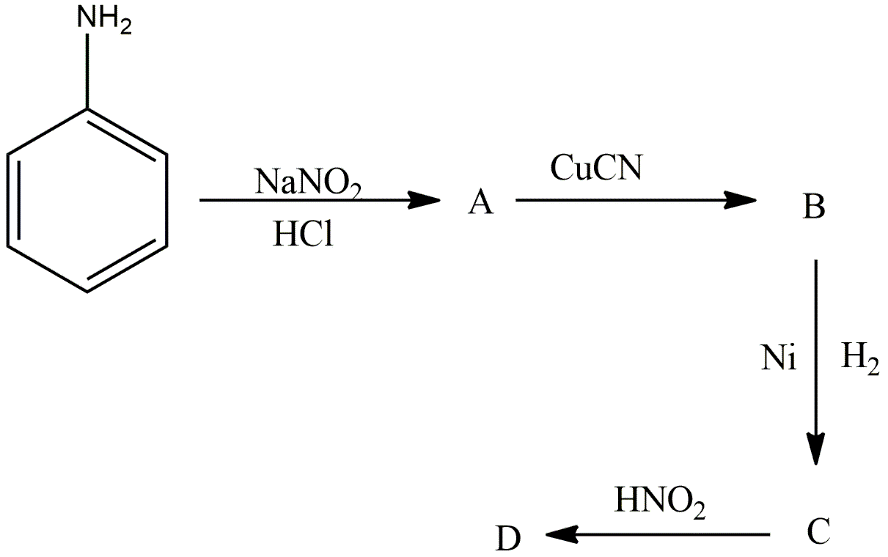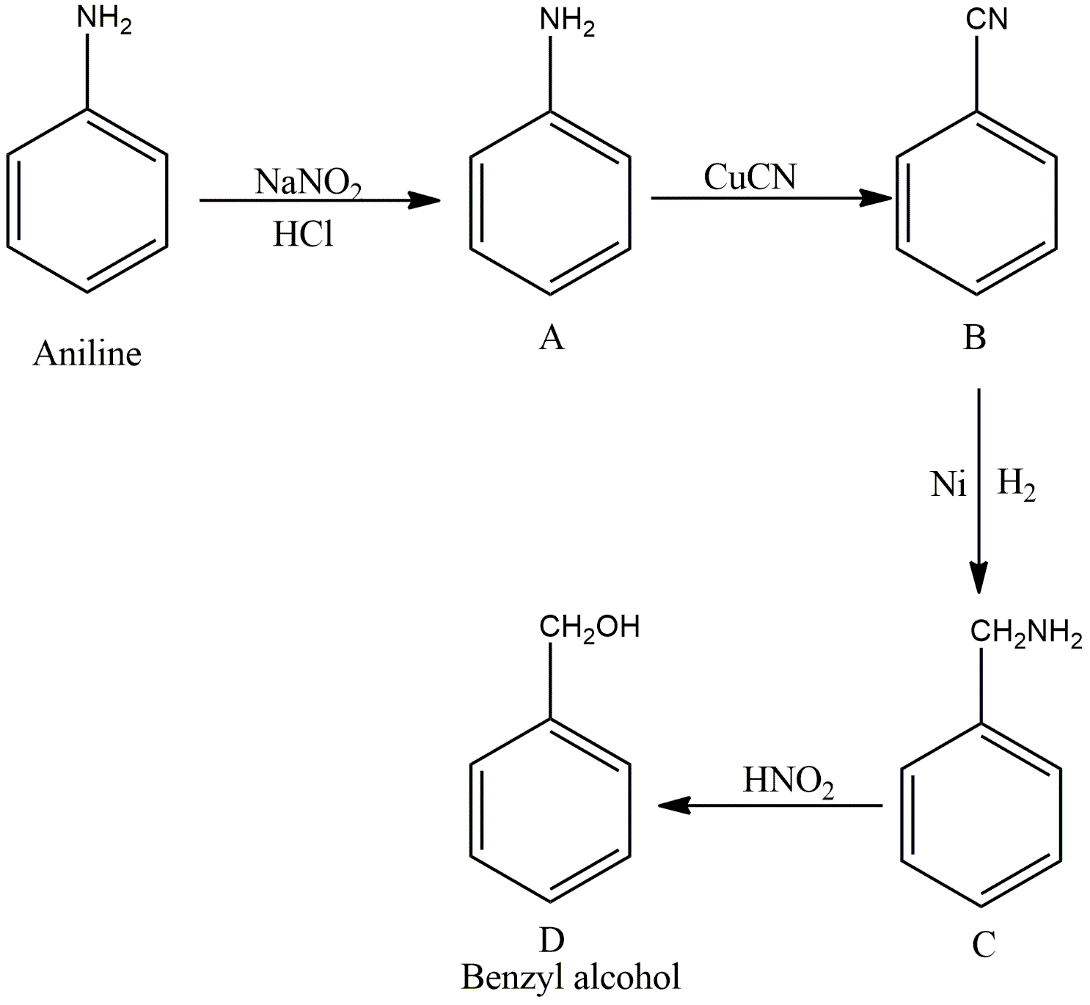
Aniline in a set of reactions yielded a product D?

The product D is:
A.\[{C_6}{H_5}NHOH\]
B.\[{C_6}{H_5}NHC{H_2}C{H_3}\]
C.\[{C_6}{H_5}C{H_2}N{H_2}\]
D.\[{C_6}{H_5}C{H_2}OH\]
Answer
219.9k+ views
Hint: Aniline is an aromatic amine having a primary aromatic amine functional group. The reaction here is an example of a coupling reaction where carbon couples with carbon to form a C-C single bond.
Complete Step by Step Solution:
In the first step, \[\left( {NaN{O_2} + HCl} \right)\]reacts with each other to form nitrous acid\[\left( {HONO} \right)\], which reacts with aniline to give a diazotization reaction and form benzene diazonium chloride salt product (A). This product (A) further reacts with copper cyanide \[\left( {CuCN} \right)\]to give a Sandmayer’s reaction and forms cyano benzene or benzonitrile product (B). Then product (B) reacts with hydrogen gas in presence of nickel catalyst to give benzylamine (C) by reduction, which further reacts with nitrous acid \[\left( {HONO} \right)\]which is an oxidising agent and forms benzyl alcohol, the final product (D). The reaction mechanism is shown below:

Image:Reaction with aniline to give benzyl alcohol
So, option D is correct.
Additional Information:Aromatic diazonium chloride salts formed by the reaction of aniline and nitrous acid are electrophiles and undergo electrophilic substitution reaction i.e., electron-loving compounds attack them. In this way, it works in coupling reactions.
In the reaction of copper cyanide with aromatic diazonium chloride salt, partial positive charges on Cu forms a bond with negative charges on chloride ion of salts and form \[CuCl\]and \[{N_2}\]releases as nitrogen gas and partial negative charges on cyanide attack the aromatic ring to form cyanobenzene.
Note: Anilines are also known as phenyl benzene or aminobenzene. Nitrous acid is a weak acid used in the preparation of diazonium salts. The reaction asked in this question is an azo coupling reaction used to form C-C bonds.
Complete Step by Step Solution:
In the first step, \[\left( {NaN{O_2} + HCl} \right)\]reacts with each other to form nitrous acid\[\left( {HONO} \right)\], which reacts with aniline to give a diazotization reaction and form benzene diazonium chloride salt product (A). This product (A) further reacts with copper cyanide \[\left( {CuCN} \right)\]to give a Sandmayer’s reaction and forms cyano benzene or benzonitrile product (B). Then product (B) reacts with hydrogen gas in presence of nickel catalyst to give benzylamine (C) by reduction, which further reacts with nitrous acid \[\left( {HONO} \right)\]which is an oxidising agent and forms benzyl alcohol, the final product (D). The reaction mechanism is shown below:

Image:Reaction with aniline to give benzyl alcohol
So, option D is correct.
Additional Information:Aromatic diazonium chloride salts formed by the reaction of aniline and nitrous acid are electrophiles and undergo electrophilic substitution reaction i.e., electron-loving compounds attack them. In this way, it works in coupling reactions.
In the reaction of copper cyanide with aromatic diazonium chloride salt, partial positive charges on Cu forms a bond with negative charges on chloride ion of salts and form \[CuCl\]and \[{N_2}\]releases as nitrogen gas and partial negative charges on cyanide attack the aromatic ring to form cyanobenzene.
Note: Anilines are also known as phenyl benzene or aminobenzene. Nitrous acid is a weak acid used in the preparation of diazonium salts. The reaction asked in this question is an azo coupling reaction used to form C-C bonds.
Recently Updated Pages
Electricity and Magnetism Explained: Key Concepts & Applications

JEE Energetics Important Concepts and Tips for Exam Preparation

JEE Isolation, Preparation and Properties of Non-metals Important Concepts and Tips for Exam Preparation

JEE Main 2021 July 25 Shift 1 Question Paper with Answer Key

JEE Main 2021 July 22 Shift 2 Question Paper with Answer Key

States of Matter Chapter For JEE Main Chemistry

Trending doubts
JEE Main 2026: Application Form Open, Exam Dates, Syllabus, Eligibility & Question Papers

Derivation of Equation of Trajectory Explained for Students

Hybridisation in Chemistry – Concept, Types & Applications

Understanding the Angle of Deviation in a Prism

Understanding Atomic Structure for Beginners

How to Convert a Galvanometer into an Ammeter or Voltmeter

Other Pages
Solutions Class 12 Chemistry Chapter 1 CBSE Notes - 2025-26

NCERT Solutions For Class 12 Chemistry Chapter 1 Solutions - 2025-26

The D and F Block Elements Class 12 Chemistry Chapter 4 CBSE Notes - 2025-26

NCERT Solutions for Class 12 Chemistry Chapter Chapter 7 Alcohol Phenol and Ether

NCERT Solutions ForClass 12 Chemistry Chapter Chapter 8 Aldehydes Ketones And Carboxylic Acids

JEE Advanced Marks vs Ranks 2025: Understanding Category-wise Qualifying Marks and Previous Year Cut-offs




